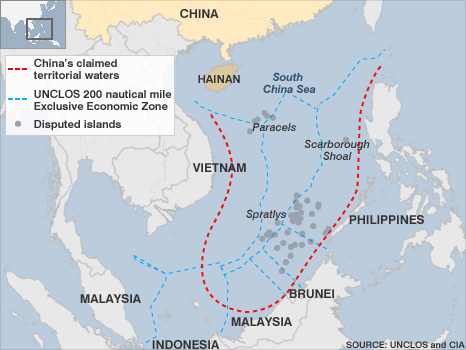A Chinese friend once told me an old Chinese saying: "Politicians come and go, the businessman always remains." So it would seem in the South China Sea. Despite political grandstanding and rhetoric over territorial disputes, natural gas and oil production grows in this corner of the world. Listen to the politicians talk if you wish, or make money on these companies instead.
Good morning, Vietnam
Vietnam has formed joint ventures with Talisman Energy (NYSE: TLM) to explore and produce their offshore oil. Talisman originally produced natural gas in Canada until the boom in US gas production dropped prices like a stone and took Talisman's earnings with them.
To compensate, Talisman focused on producing oil. Some oil production comes from safe plays like the Eagle Ford in Texas; other plays like Vietnam are decidedly riskier. Talisman owns interests in two offshore blocks and in a Vietnamese company exploring these blocks. Talisman initially forecast production of 8,000 barrels of oil equivalent (boe) a day in 2013. During its latest corporate presentation, the company claims production is now 12,000 boe a day.
Talisman's other Asian assets include Indonesia, where Talisman has interests in both onshore and offshore plays. The most important is the Corridor play, which accounts for 45% of Talisman's Asian production. Other plays in the neighborhood are Talisman's Malaysian offshore oil and gas assets. Despite these positive Asian developments, Talisman's overall earnings and stock have yet to rebound.
Big Oil in the South China Sea
With operations in Vietnam, Indonesia, the Philippines, and China, Chevron (CVX +0.22%) has the South China Sea covered. Actually, the second largest US integrated oil company has pretty much the whole world covered. Chevron operates seemingly everywhere, including such difficult places as Argentina, Kazakhstan, and Russia. Of late, the company has been building its Asian operations, likely in response to the growing economies and oil and gas discoveries in that part of the world.
In its size there is safety. No one operation going bad will sink the company. For investors, Chevron offers $21 billion in cash, $11 billion in debt, and a 3% and growing dividend. Stock buybacks further support the stock. Future plans focus on upstream production. With $21 billion in the bank, Chevron can fund its own acquisitions for future growth.
No matter who explores, they need drill ships
Think of it as a "picks and shovels" investment. Companies drilling for offshore oil need the ships, or rigs, that Seadrill (SDRL +0.00%) leases. The company boasts one of the most modern fleets in the world. After a disappointing 2012, Seadrill bounced back with positive earnings surprises in the first two quarters of 2013. A pop in the stock price and a dividend increase came with the good news. Looking ahead, the company claims $19.1 billion in backlog to support future growth in an industry that continues growing. According to its website, Seadrill currently operates 10 rigs in the South China Sea with another under construction slated for Vietnam.
The only dark cloud on Seadrill's horizon is its debt. The company is heavily leveraged compared to its peers and just announced a $500 million debt offering. The question here centers on how that debt is being used. The company continues building new rigs that are in high demand and usually contracted before they are built. The company's debt to equity ratio has also declined from a peak in 2012. So far, it seems the debt is manageable and properly used.
What's all the fuss about?
In a nutshell, at least five different countries claim the same real estate in the South China Sea. Actually, most countries recognize each other's maritime borders, but China doesn't. As the map below shows, China claims the entire South China Sea for itself. This goes over poorly with its neighbors. Vietnam began exploring for oil and gas in a disputed region off the Vietnamese coast, and this agitated China.
The stakes are high. The US Energy Information Administration estimates 11 billion barrels of oil and 190 trillion cubic feet of natural gas in proved and probable reserves lies under the waves. How will this end? Good question, but many believe some sharing agreement will be hammered out. Just might take some time to do all the hammering.
Source: Council on Foreign Relations
Final Foolish thoughts
All around, Chevron offers the most safety of the three companies presented here. Its sheer size and diversity protect it from any upheaval in the South China Sea. With a little more risk tolerance, you can enjoy a better dividend with Seadrill. It sports an impressive order backlog and with the demand for oil growing, it's not likely to run out of business anytime soon. Just wish its debt load wasn't so heavy. Talisman is making money in the South China Sea, but it's a turnaround story in progress. There are no guarantees the story will end well.







